This is an updated version of the brief article published in the December 2016 issue of Common Stock, the journal of the Lowland and Border Pipers’ Society. Here the article has been expanded by the inclusion of more music notations and some audio examples.
———-
Anyone familiar with Dixon’s fine collection of tunes that were probably circulating on both sides of the Scottish border during the early decades of the 18th century will know of the problem of how best to interpret his notations. They stem from the facts that he did not identify the instrument[s] he was writing for, that he used a four-line music stave and moreover that he included no key signatures. The solutions proposed below emerged from a close examination of the melodic content and the sonorities of Dixon’s tunes and it is this that prompts me to suggest a different scale/tuning for the historic Border pipes than that commonly used today.
Throughout the collection Dixon specified the lowest line of his stave was for the note G, so I have added a line below each four-line stave to create the modern five-line treble clef in the examples I give below. I believe that no transposition of pitch is needed except for the very first tune in the manuscript (initially labelled Dickes a way) for this seems to have been a ‘false start’ to the collection. It is clearly in a different hand and a close examination of the first few pages of the bound volume shows no watermark on these pages, unlike the later pages.
These early pages also show evidence of having been bound together at a later date with the main body of the collection which begins with the tune Doringtown. While the first tune (Dicke’s a way, later labelled Watty’s away) is written on the recto and verso of a single sheet and numbered pages 1 and 2, the first page of Doringtown is also numbered page 1 and subsequent page numbering follows on from there throughout the manuscript. This strongly suggests that the very first tune formed part of an earlier start to the collection which was perhaps abandoned and furthermore that the accompanying instruction – to transpose tunes down a tone – should apply only to that first tune which occupies the recto and verso of a single sheet.
Since Dixon felt it unnecessary to include key signatures I have needed to consider the best musical sense the tunes make to me when choosing suitable key signatures , and it was also important to compare them with other early versions – (sources such as the Balcarres, Sinkler and Vickers manuscripts) and my own appraisal of the general melodic features of early 18th century Lowland Scottish and Border songs.
But firstly, what instrument did Dixon write his tunes for and how were they tuned? Can we be sure he was writing for bagpipes? Consider for example the low octave of a modern treble recorder (in F) which fits the tunes perfectly. Recorders did not have a standard scale in the 18th century, but the use of cross- fingerings often allowed one to play chromatic changes of notes B, F and E and hence to play tunes in the keys of C, F, G and G minor and Bflat with ease. Admittedly much writing for recorder spans more than nine notes, though some recorders were notoriously out of tune in their second octave and rural players of Dixon’s time may well have confined their playing of ‘local’ tunes to the bottom octave. It is known that recorder tunings were not standardised in the 18th century and the many contemporary fingering charts varied, especially with regard to the low B – flat or natural.
I’ve mentioned the recorder as just one example of other possible instruments than bagpipes for Dixon’s repertory. If, as many of us accept, he was indeed writing for bagpipes then a lack of standardised tuning could also have been true for bagpipe chanters in and around the Scottish borders during Dixon’s time. Any evidence that professional or amateur woodwind instrument makers of his day were producing Border bagpipe chanters that had one standard tuning would be welcomed.
What then could have been the scale of the Dixon’s instrument[s]? We cannot rule out the possibility that Dixon noted down tunes for more than one type of bagpipe. His notations range over a 9-note scale from nominal low F to high G. This works well for a 9-note bagpipe chanter, though like others before me (e.g. Hensold) we can accept also that a number of Dixon’s tunes with a range of only 8 notes could fit an 8-note Northumbrian Smallpipe. Close examination of the tunes leads me to suggest that the nominal scale of any conical border chanter which he played would have sounded close to that shown below, including flat or neutral tunings of the notes B and E. By neutral I refer to a note whose frequency lies roughly halfway between two adjacent semitones (such as B and Bb, or E and Eb, F and Fsharp). Depending on their surrounding musical context, neutral tunings today are usually perceived as either one or other note in our modern chromatic pitch system, because music psychologists have shown that humans categorise musical pitch – though categories vary from one culture to another. (Siegel et al). For instance, the early church missionaries in Uganda found that their native church members found it impossible to sing semitone intervals (e.g. te to doh) because their own music was based not on seven pitch categories but five, from which semitone intervals were absent. Working with his own field recordings Percy Grainger in 1908 made a fairly convincing case in relation the use of ‘neutral modes’ in English folksong when he discovered that some of his informants consistently sang 3/4-tone intervals when performing for him (Grainger, see also Boswell ) .
Two 8-note scales are also indicated: this allows for the possibility that Dixon also played the Northumbrian Smallpipe or wanted to include such tunes in his collection. In this case the flat B and E might not be needed in the G scale. In this G scale also an Fneutral or Fsharp would prove an acceptable ‘leading’ note for many of the Smallpipe tunes, though some of those 8-note tunes listed below call for prominent Fnaturals, even though by the early 19th century many similar tunes were notated with Fsharp. As for drones to suit these scales then at least F and G drones should be available. Other drone tunings for the Border pipes such as Bflat are also possible, for at least two tunes classified below as having a Bflat sonority sound pleasant to a modern ear with such a drone, though a G drone also works reasonably well with them.
It now remains to be seen how well this proposed bagpipe scale might fit Dixon’s repertory.
A brief summary of Dixon’s nine-note tunes.
All the following tunes make better sense with Fnaturals and Bflats, as well as possibly neutral Es (or a fingering that allows a pitch of Eflat to be produced).
F major sonority – needs Fnatural and a flat or neutral B.
Doringtown. (Rhythm rationalised in strain 2):- [click to enlarge]

Most early versions of this tune are in the same major sonority. John Rook simply seemed to have forgotten to change his key signature from that used for the previous piece on page 126 of his collection. Dixon’s version is not really ‘polymodal’ but for many strains it does venture upwards into dominant sonority (key C) for three bars before usually returning to F via the same cadential phrase as in his opening strains. In the last two strains of this 14 strain tune the seemingly deliberate discords that occur when the note E is stressed are intriguing but discomforting to some listeners.
(All the audio excerpts that follow have been created using a keyboard and an equal temperament Korg synthesizer).
The Black and the Grae. This is very similar to Margaret Sinkler’s The Horseman’s Port with its alternating Fmajor and Gminor sonorities, though she does not use a one-flat key signature and specifies Bflat only for the fourth bar from the end of each strain. Other versions contain alternating phrases in F and G major sonorities which might suggest that Bneutral fits the tune better, unless Dixon’s pipes could sound both Bflat and B natural by using cross-fingering. Later, however, Nathaniel Gow printed a version alternating between F major and G minor sonorities, i.e. using Bflat throughout, in his Complete Repository (vol 2. p 8-9).
Berwick Bully. Here the note E only occurs as a passing note (mostly unaccented) among running quavers so the tune could be acceptable with any of the E tunings. A brief sample follows. There is doubt about the pitch of note5 in strain2 bar 3 (Dixon wrote F).

B flat major sonority Needs Fnatural and Bflat (or Bneutral) and Eflat (or Eneutral).
Hacky Hony. Better with Eflat.
A brief sample (in this case with a Bflat drone) with the notation:
Hay for Newbeginn. Better with Eflat. See and hear the setting further below.
G sonority Needs F natural top and bottom and – if in a minor sonority – B flat or at least B neutral.
Have a care on her Johnie. Effective with Bflats and probably better with Eflat or neutral than with Enatural.
Cuddy Clad her. In other versions, both G major and G minor sonorities are found.
Cock on the midding. Could be major – though minor also sounds acceptable.
There was a weddin[g] etc. Strain 2 goes into relative major (B flat sonority). Are Eflats or Eneutrals also needed?
Saw ye never’ a Bonie [lass]. Probably with Enatural or Eneutral if it is to correspond with Vickers: I do not accept that Vickers’ inclusion of Bflat was probably a mistake. See the discussion of this tune below.
Wallington.
A problem tune because there exist so many versions, some in major and others in minor sonorities. Clough’s version is interesting – its minor feel ties in well with Dixon’s setting which could then be seen to employ the two alternating sonorities, G minor and F major.
More ambiguous G sonority.
Hit her between the legs. Could it earlier have been Bneutral or Bflat?
She will never be guided. Needs at least Fnaturals.
Golden Lock[s] Certainly needs Fnaturals.
F and G (minor?) sonorities
Dickes a way Marked by frequent abrupt changes of sonority between F and G. Bflat and possibly Eneutral can sound acceptable.
C sonority
If thou wert my own thing. Hexatonic (no Bs in the tune) needs Fnatural
Indeterminate.
The New way to Morpeth. Opening strains 1 and 3 sound as if in F sonority with Bflat or Bneutral. Other variations are in C sonority with Bnatural or neutral which contribute to a seeming mixter-maxter of tune phrases. One wonders if these other variations represent in fact the ‘new way’ of performing the work and also what the ‘old way’ might have been like.
DIXON’S 8-NOTE TUNES.
All the following tunes with the exception of the last two could have been set for (early) Northumbrian Smallpipes though some of them could also have been played on the 9-note pipes and so could have had Bflat available (e.g. John Cudbursun’s Fancy).
If for early Northumbrian pipes the pitch of the high F is not known, then it could have been natural or neutral enough to suit different modal requirements. There is evidence that decades later Peacock and others sharpened Fs that earlier were natural (or possibly neutral) when setting tunes for the Northumbrian pipes. Note that none of these tunes insist on the need for Bflat other than the last three listed here as having mixed sonorities
G major sonority There is often uncertainty about the pitch of the high leading note F and it is worth noting that many prominent high Fs among the next batch of tunes are given ornament signs (presumably trills or turns), perhaps to disguise the fact the F available may not fit well with the surrounding melodic context or the drone.
John Cudbursun’s Fancy. Major moving to A minor sonority for last bar of each strain. The note F is only sounded within quaver running figures.
Minuat – King Edward the Second. Probably major.
The Stool of Repentance. Major. F sounded only within running figures
High Lands Laddy. Major
Wally as the Marques ran. Major with F sounded only within running figures
Soulters of Sellkirk. Major – with ?F neutral.
Lasses bushes Brawlie. Prominent Fnaturals (or neutral)
Adam a Bell Major. The ornamented minim F in bar1 strain2 may have been Fnatural. Later versions use Fsharp.
Gingleing Gordie. Major. Unlike Dixon, Vickers includes a high A. This supports the view that Dixon’s version was for Smallpipes.
My love comes passing by. Major. The ornamented minim F in bars 2 of early strains may have been Fnatural. Later records show the use of Fsharp.
The Prentice Lads of Alnwick. Major
Cut and dry Dolly, new way. Major
Nickle Foster’s horn pipe. Major
Mock the Soulders Lady. Major
The newe way to Bouden. Prominent Fs which could be natural or neutral.
Jake Lattine. Major
Ratling Roring Willie. Major with F naturals.
C sonority
Lases make yo’r tails toddle. Needs Fnaturals. Could join the 9-note group.
Cannie Willie Foster. Also needs Fnaturals and could join the 9-note group.
8 notes but probably intended for 9-note Border pipes.
Mixed sonorities
Little wee winking thing. Begins with A minor and G major sonorities but Cmajor also featured. Needs high Fnatural or neutral.).
Young and Lustie was I. Ambiguous mode. Certainly needs F natural: also Bflat or Bneutral and Eflat or E neutral.
Here it is with E flat:-
And here, a fragment using Enatural:-
Ov’r the Dyke & Till her. G minor sonority. In the manuscript this follows immediately on from Young and Lustie was I. But see the discussion below.
Finally – there are precedents for arguing that some minor sonority tunes can have been changed to major during the course of the 18th and 19th centuries. This is especially likely to occur where neutral tunings have been ‘rationalised’. One very recent fiddle music example is the Shetland tune Da Boanie Isle o’ Whalsay. Today it is played with A major sonority but in the 1970s some fiddlers were playing and singing it with neutral Cs while a 19th century manuscript shows it set in the minor sonority (with Cnatural) (Cooke, p. 101). Among Dixon’s tunes Cuddy clad Her is such a possibility.
Some further examples.
Hay for Newbeginn Here is the facsimile of the opening few lines in Dixon’s manuscript:
Below are the openings of two versions for consideration. Neither of them represent the way current performances sound when the melody is transcribed for playing on the modern Lowland pipes (or the Highland bagpipes for that matter).
Version 1: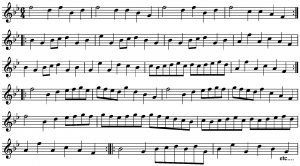 This calls for an ability to sound Bflat and Eflat on one’s instrument (or at least neutral Es – neither flat nor natural) and gives a sonority fluctuating between Bflat major (C-mode) and G minor (A-or D-mode). As a bagpipe tune G would be a good drone pitch though Bflat is a possible alternative.
This calls for an ability to sound Bflat and Eflat on one’s instrument (or at least neutral Es – neither flat nor natural) and gives a sonority fluctuating between Bflat major (C-mode) and G minor (A-or D-mode). As a bagpipe tune G would be a good drone pitch though Bflat is a possible alternative.
Version 2: Here Dixon’s tune has been transposed up one tone:-
 This transposition would call for A or C as a drone pitch. As with many Scottish and Border melodies there is the same fluctuating sonority here, moving between major opening (C sonority) and its ‘relative minor’ (A). The beginning of the third strain is included to show that for a keyless Northumbrian Smallpipes of the early 18th century then this transposition goes too high. But at this pitch it agrees perfectly with John Bell’s version (in his Northumbrian manuscript dated c1812), the sole reason for including this transposed version here. Bell gives only two strains – as follows:
This transposition would call for A or C as a drone pitch. As with many Scottish and Border melodies there is the same fluctuating sonority here, moving between major opening (C sonority) and its ‘relative minor’ (A). The beginning of the third strain is included to show that for a keyless Northumbrian Smallpipes of the early 18th century then this transposition goes too high. But at this pitch it agrees perfectly with John Bell’s version (in his Northumbrian manuscript dated c1812), the sole reason for including this transposed version here. Bell gives only two strains – as follows:
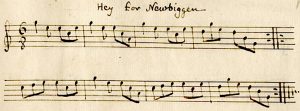 In both Dixon’s and Bell’s versions there is an absence of tritone relationships that one finds in other transcriptions (intervals between notes such such as Csharp and Gnatural or Bnatural and Fnatural). This can be a particular problem if one plays this on the Highland bagpipes or smaller pipes with a similar scale. Such intervals, awkward to sing if not to play, are not a common feature of Lowland or Highland Scottish traditional song style, though one can find tritone relationships in later recorded versions which have clearly been modified to suit the addition of triadic harmonies for keyboard accompaniments.
In both Dixon’s and Bell’s versions there is an absence of tritone relationships that one finds in other transcriptions (intervals between notes such such as Csharp and Gnatural or Bnatural and Fnatural). This can be a particular problem if one plays this on the Highland bagpipes or smaller pipes with a similar scale. Such intervals, awkward to sing if not to play, are not a common feature of Lowland or Highland Scottish traditional song style, though one can find tritone relationships in later recorded versions which have clearly been modified to suit the addition of triadic harmonies for keyboard accompaniments.
Ov’r the Dyke & till her Laddy is another tune which demands both Bflat and Eflat or Eneutral. Here are the first two strains:-
Without a Bflat this transposition would again produce frequent uncomfortable diminished 5th (tritone) intervals in relation to the Fnatural. The Eflat also seems necessary to complement Bflat and make the tune modally more like many Lowland Scottish songs that float between a minor sonority (in this case G) and its relative major (Bflat). I’m grateful to Peter Stewart who drew my attention to a setting of The Peer of Leith in Adam Craig’s Collection (1730, p.14) which is almost contemporaneous with Dixon’s manuscript. This tune has a recognisably similar opening and sonority to the version above though it is set at a lower pitch. Two other early versions of Ov’r the Dyke are in the Balcarres lute manuscript(no. 24) and in Vickers’ collection and both feature the same minor sonority as Dixon.
The problem tune (8 notes)
Watty’s away. What can we conclude about the very first tune, erroneously labelled Dickes a way and written in a different hand from all other tunes? If the advice on the facing page is followed and the tune is transposed down a tone it gives it a clear Bflat sonority just as with Hacky Hony and Hay for Newbeginn. Vickers’ version called Cock up thy Bever is written a tone higher but has an identical sonority to Dixon’s.

Here it is, accordingly transposed down a tone as advised.
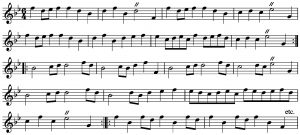
Saw ye never a bonie Lass.
A final example reinforces my view that Bflat (or at least a neutral B) is called for in the scale, though it leaves me feeling less certain about calling for a flat E rather than a neutral E. The tune, which has a G minor sonority, sounds convincing using either the note Eflat (making it, in recent terminology, an A-mode tune) or with a neutral or plain E (which makes it more a D-mode tune), though my personal preference is for the second. My choice is endorsed by Vickers (p. 76) who, a generation later, notated his version, called Kis’d Hir under the Coverlid, with the same tonic and with a single Bflat for his key signature. Nevertheless, the final undulating strain sounds particularly effective sounding Eflats and with a G drone. Take your pick!
And here a slightly shorter version with E natural.
There remain a couple of problems for those wishing to play this repertory and stay faithful to what I think Dixon intended. Firstly – we don’t know enough about his pipes with regard to what drone pitches would have been available to him. I have suggested some but there are others where it may be difficult to conclude which drone pitch best suits a particular tune even if that that pitch were available. Lastly, if my recommendations are accepted, it must be clear that a number of Dixon’s tunes, even if transposed, cannot be well represented using chanters with Highland bagpipe tuning (from low G up to high A with C# and F#) unless they are equipped with keys or unless the scale can be temporarily modified in some other way.
References.
George W. Boswell : 1970. ‘The Neutral Tone as a Function of Folk-Song Text’, Yearbook of the International Folk Music Council, vol2 (127-132)
Cooke, Peter: 1986. The Fiddle Tradition of the Shetland Isles. Cambridge University Press, (101)
Craig, Adam: 1730. A Collection of the Choicest Scots Tunes, Adapted For the Harpsicord or Spinnet and within the Compass of the Voice, Violin or German Flute. Edinburgh.
Hensold, Dick: 2004. ‘Smallpipe Tunes in the Dixon Manuscript and the Peacock Collection’ in Out of the Flames – Studies on the William Dixon Bagpipe Music manuscript (1733), (19-25)
Grainger, Percy: 1908–9. ‘Collecting with the Phonograph’, Journal of the English Folk Song Society, vol. 3, (147–162)
Peacock, John: c1800-1805. A Favorite Collection of Tunes with Variations Adapted for the Northumberland Small Pipes violin or Flute. Printed by W. Wright, Newcastle.
Siegel, Jane A: Siegel, William: 1977. “Categorical perception of tonal intervals: Musicians can’t tell sharp from flat, Perception & Psychophysics, Vol 21/5: 399-407).
Sinkler, Margaret: 1710. Fiddle and keyboard book, National Library of Scotland MS 3296 (Glen 143i).
Spring, Matthew: 2010 The Balcarres Lute Book (2 vols.) Universities of Aberdeen and Glasgow.
Vickers, William: c1770 Tune Book Manuscript available on line at:-. http://www.farnearchive.com/detail.asp?id=R0300000
___________________________________________
Updated April 20, 2017.


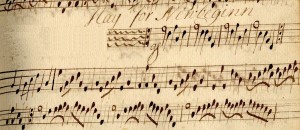
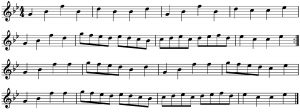
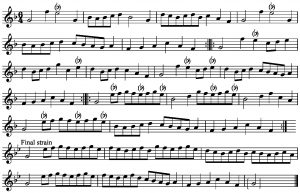
What a fascinating discussion of this most intriguing topic! Thank you.
Glad you liked them, Peter. When it was brought to the attention of the member of the Lowl
and and Border Bagpipe Association it met with 98% disagreement by pipers with my views. It was a fascinating discussion until it began to get personal. I’ve since tested some dual versions for 6 tunes with a number of Scottish musicians and students and found what I considered remarkable tolerance for the modal ‘inconsistencies’ which I referred to. When I’ve had the chance to interview more I’ll write up my findings, quoting the remarks made by listeners.
Hi Peter,
I have also been thinking for some time now that the relationship between (Dixon´s) the instrument and the notation needs further study. Although I consider the Border pipe/Small pipes a contender, I also think other instruments would suit the repertoire equally as well, and this has not been explored much in the piping world, e.g. the recorder, Stock and Horn…etc. Also, why did nt Dixon write a drone in his notation? After spending so much time writing out the notation a simple indication to the Drone note would of been easy to do, unless there was no drone? Also after playing the notation for many years I find the relationship between the instrument and the notation revealing. Certain instruments fair better than others when it comes to range, and Dixon has many phrases where he plays in the top/upper range of the scale, this does not always fit easily with the top hand fingering of the Border pipes (especially if one is cross fingering) with runs and trills etc. But it does with closed fingering (NSP).
I also question the root note of the notation and I believe a more fluid approach is need to explore the musical possibilities, as you mentioned minor and major, and different modes. More work needs to be done on the surviving instruments to see what pitch, scale and fingering is available/possible and then this can be married with the notation.
I really enjoyed your article and I will read further with interest.
Thanks for this thoughtful reply, Kevin. You seem to be asking many of the questions that I asked. About drone however, I would only say that there does not seem to have been any practice among Scottish pipers to include the drones in their notations. They assume that the drone is unchanged so there is no need to include it. But I still keep thinking about that one intriguing reference by Joseph MacDonald in his ms to the drone “unless they be changed”. I suppose you read the sometimes rather heated responses from LBPS pipers in their facebook pages – over 100 and nearly all of them disagreeing with my caveats. I’ve since been trying to do a bit of research testing responses to hearing two versions of a small number of the ‘problematic’ tunes. The sample is currently too small but it is clear that pipers have grown very used to what they sometimes called the ‘ modern’ versions. If I could first get a larger sample I’d publish the results.
Peter:
I have found this article very interesting and would like to know your thoughts on time signatures in the William Dixon MS as well as key signatures.